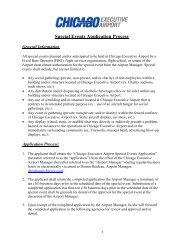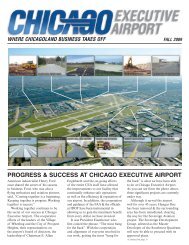Here - Chicago Executive Airport
Here - Chicago Executive Airport
Here - Chicago Executive Airport
You also want an ePaper? Increase the reach of your titles
YUMPU automatically turns print PDFs into web optimized ePapers that Google loves.
<strong>Chicago</strong> <strong>Executive</strong> <strong>Airport</strong> Economic Impact Study–2007 Page 2-1<br />
Chapter 2 - Demographic & Economic Trends<br />
Various industries in the State of Illinois, and specifically within the greater <strong>Chicago</strong> area, are<br />
dependent on air transportation for the sustainability of current operations and for expanding<br />
market access to customers, suppliers, and business collaborations. Air transportation enables<br />
industries and specific companies to become and remain competitive in an economic<br />
environment that persistently compels an increasingly quicker and more efficient exchange of<br />
goods, services, and ideas. This section summarizes recent trends in population, current<br />
employment, and household income levels. This data provides the context from which to<br />
compare the airport economic impact findings presented in the subsequent sections.<br />
2.1 Population<br />
Cook County is, by far, the largest populated county in the State of Illinois and the second<br />
largest populated county in the United States, next only to Los Angeles County, California. In<br />
fact, with nearly 5.3 million people in 2006, Cook County has a population greater than the<br />
population of 31 states. 3 <strong>Chicago</strong> is located within the entirety of Cook County and contributes<br />
to the large population. However, Cook County population declined slightly (3.7%) from about<br />
5.49 million in 1970 to 5.29 million in 2006, as shown in Exhibit 2-1. Conversely, Lake County,<br />
Illinois, which is located between the borders of Cook County and the State of Wisconsin, nearly<br />
doubled over the same historical time period, growing from about 382,000 to 713,000 people.<br />
Exhibit 2-1<br />
Historical Population Trends (1970 to 2006)<br />
<strong>Chicago</strong> <strong>Executive</strong> <strong>Airport</strong> Economic Impact Study<br />
Population Year<br />
Change<br />
Geography 1970 1980 1990 2000 2006 1970-2006<br />
Study Area<br />
Cook County 5,493,766 5,253,628 5,105,067 5,376,741 5,288,655 -3.7%<br />
Lake County 382,638 440,388 516,418 644,356 713,076 86.4%<br />
Subtotal 5,876,404 5,694,016 5,621,485 6,021,097 6,001,731 2.1%<br />
State of Illinois 11,110,285 11,427,409 11,430,602 12,419,293 12,831,970 15.5%<br />
Source: 1990 Census of Population and Housing, Population and Housing Unit Counts, and 2000 Census<br />
Between 2000 and 2030, population in the Cook-Lake County study area is expected to grow, in<br />
nearly 14% while the State of Illinois is expected to grow at almost 22%, as shown in Exhibit 2-<br />
2. Lake County is expected to grow more quickly than Cook County and Illinois, due lack of<br />
physical room for expansion due to high population density.<br />
3 US Census Bureau: Annual Estimates of the Population for the United States, Regions, and States and<br />
for Puerto Rico: April 1, 2000 to July 1, 2006<br />
Wilbur Smith Associates November 2007




